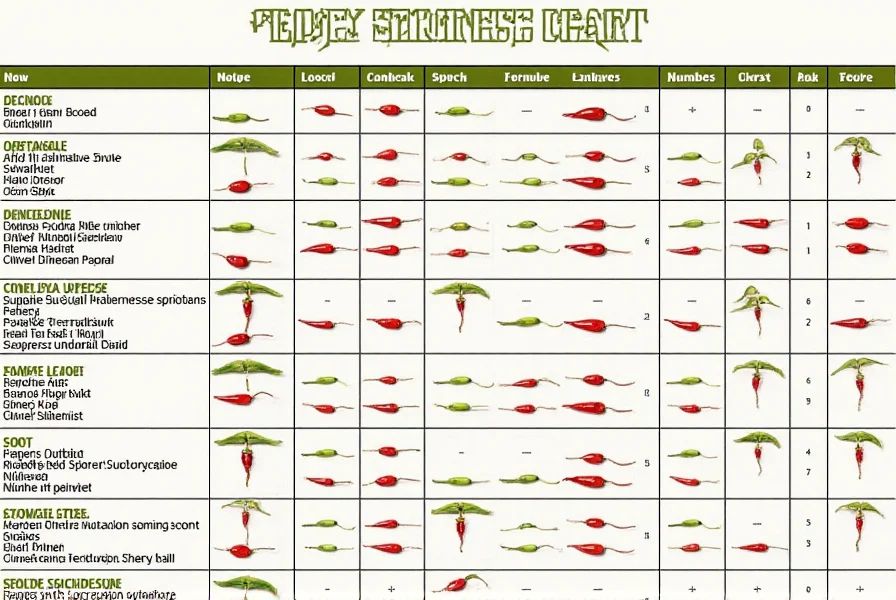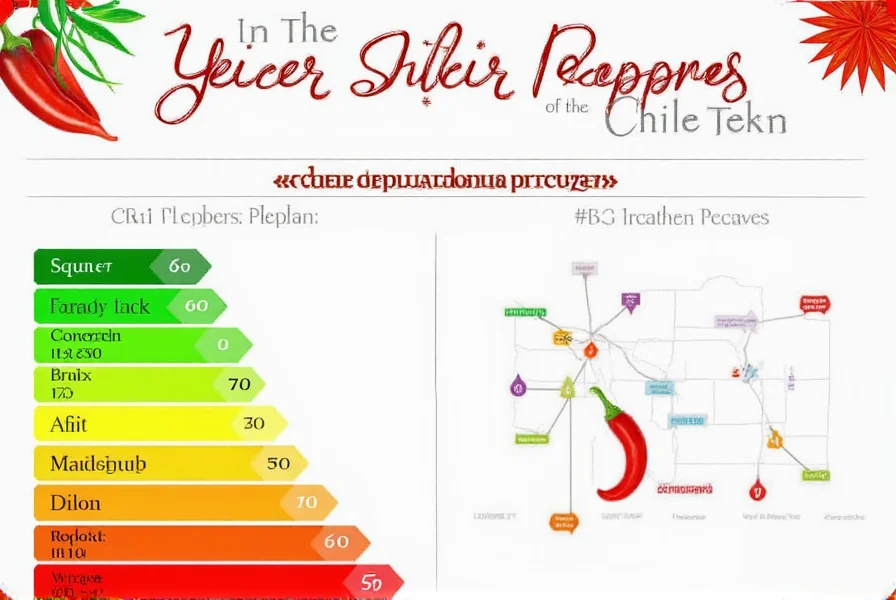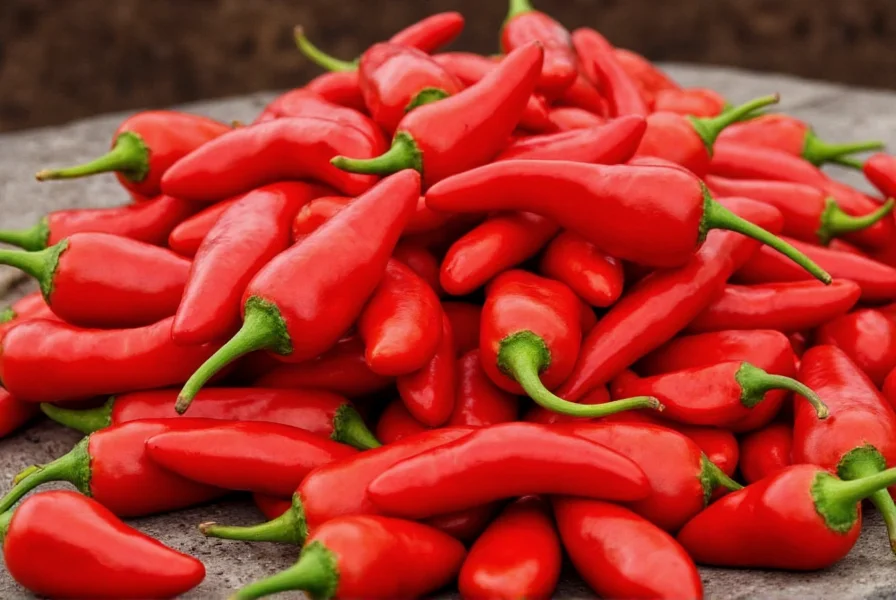The chili pepper heat chart, measured in Scoville Heat Units (SHU), ranks peppers from mild to extreme. This guide explains how the Scoville scale works, compares common peppers, and provides practical tips for using heat levels in cooking. Whether you're a beginner or a spice enthusiast, understanding this chart ensures the perfect balance of flavor without unwanted heat.
Table of Contents
- What is the Scoville Scale?
- Common Chili Peppers and Heat Levels
- Practical Tips for Using Heat Levels
- Buying Guide: Choosing the Right Pepper
- Frequently Asked Questions
What is the Scoville Scale?
The Scoville scale measures chili pepper heat by quantifying capsaicin concentration. Developed in 1912 by Wilbur Scoville, it assigns Scoville Heat Units (SHU) based on how much sugar water is needed to neutralize the heat. Modern testing uses high-performance liquid chromatography for precise measurements.
Here's a simplified breakdown of common heat ranges:
- 0 SHU: Bell peppers (no heat)
- 100–1,000 SHU: Poblano, Anaheim
- 1,000–10,000 SHU: Jalapeño, Serrano
- 10,000–50,000 SHU: Habanero, Thai Bird's Eye
- 50,000–100,000 SHU: Scotch Bonnet, Ghost Pepper
- Over 100,000 SHU: Carolina Reaper, Bhut Jolokia
| Chili Pepper | Heat Level (SHU) | Flavor Profile |
|---|---|---|
| Bell Pepper | 0 | Mild, sweet |
| Jalapeño | 2,500–8,000 | Earthy, slightly fruity |
| Habanero | 100,000–350,000 | Smoky, citrusy |
| Ghost Pepper | 855,000–1,040,000 | Peppery, smoky |
| Carolina Reaper | 1,400,000–2,200,000 | Very hot, slightly sweet |

Practical Tips for Using Heat Levels
- Start low, go slow: If new to spicy food, begin with peppers under 1,000 SHU like poblanos. Gradually increase heat as your tolerance builds.
- Remove seeds and membranes: Capsaicin concentrates in the white pith (placenta), not the seeds. Removing these reduces heat by up to 90%.
- Balance with dairy: Milk, yogurt, or sour cream neutralize capsaicin better than water. Casein protein binds to the heat compound.
- Wear gloves when handling hot peppers: Especially for peppers above 50,000 SHU. Avoid touching your eyes or face.
- Test before serving: Always taste-test dishes before serving, as heat levels vary by growing conditions and ripeness.
Buying Guide: Choosing the Right Pepper
For Beginners (0–5,000 SHU)
- Poblano: Mild heat (1,000–2,000 SHU), rich flavor. Ideal for stuffing or roasting.
- Jalapeño: Moderate heat (2,500–8,000 SHU). Perfect for salsas and tacos.
- Anaheim: Very mild (500–2,500 SHU). Great for green chile sauces.
For Intermediate Cooks (10,000–50,000 SHU)
- Serrano: Bright, crisp heat (10,000–25,000 SHU). Excellent for fresh salsas.
- Habanero: Fruity, smoky heat (100,000–350,000 SHU). Use sparingly in sauces or marinades.
Dried Chili Varieties
- Ancho: Dried poblano (1,000–1,500 SHU). Sweet, raisin-like notes for mole sauces.
- Chipotle: Smoked jalapeño (2,500–8,000 SHU). Adds depth to stews and adobo.
- Cayenne: Consistent heat (30,000–50,000 SHU). Ideal for spice blends and hot sauces.


Frequently Asked Questions
-
What is the Scoville scale and how does it work?
The Scoville scale measures chili pepper heat by determining capsaicin concentration. Developed in 1912, it originally used human taste testers to find dilution points. Today, high-performance liquid chromatography provides precise SHU measurements. Higher SHU = more heat.
-
Why do peppers of the same variety have different heat levels?
Growing conditions (soil, climate, rainfall), ripeness, and even the pepper's position on the plant affect heat. A single jalapeño can range from 500–8,000 SHU. Store-bought peppers often have more consistent heat than home-grown ones.
-
What's the difference between 'chile' and 'chili'?
'Chile' (pronounced 'chee-lay') refers to the pepper itself, especially in Latin American contexts. 'Chili' (pronounced 'chill-ee') typically describes dishes like chili con carne. Both terms are used interchangeably for heat charts, but 'chili pepper' is the most common search term.
-
How can I reduce heat if my dish is too spicy?
Add dairy (milk, yogurt), sugar, or acidic ingredients (lime juice, vinegar). Avoid water—it won't help since capsaicin is oil-based. For severe cases, eat bread or rice to absorb the heat.
-
Which pepper is currently the hottest in the world?
The Carolina Reaper holds the Guinness World Record at 1.4–2.2 million SHU. Unverified peppers like Pepper X claim higher heat, but official testing is required for certification.
-
How do I safely handle super-hot peppers?
Wear nitrile gloves, work in a well-ventilated area, and avoid touching your face. After handling, wash hands with soap and oil-based cleaner (like dish soap). Never use water alone—it spreads capsaicin.
-
Why do some peppers taste sweeter than others at similar heat levels?
Flavor compounds vary by pepper type. Habaneros have fruity notes, while ghost peppers have smoky undertones. Capsaicin causes heat, but other compounds create flavor profiles. This is why some peppers feel "hotter" than others at similar SHU levels.










 浙公网安备
33010002000092号
浙公网安备
33010002000092号 浙B2-20120091-4
浙B2-20120091-4